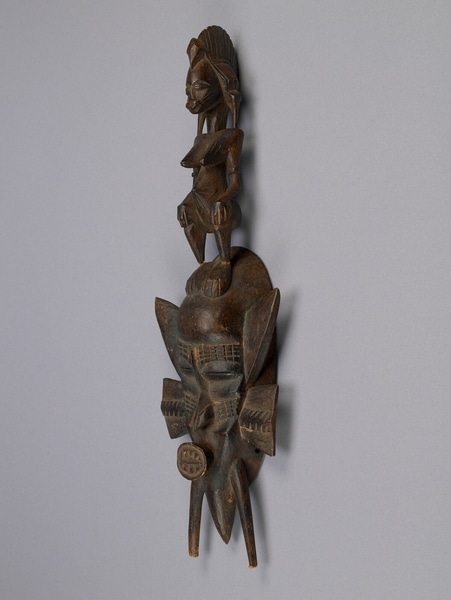Mask Item Number: 1373/28 a-b from the MOA: University of British Columbia




Description
The main part of the mask (part a) has slits carved out for the oval eyes. The ears are pointy triangles, and the nose is also pointed downward. The eyebrows and moustache are carved with a rectangular pattern. Protruding out at the sides of the mask are two trapezoids, one at each end, which have a feather-like pattern carved horizontally in the middle. The oval mouth with teeth protrudes out at a sharp angle. The bottom of the mask has two "legs". The top of the mask has two feet from which part b has broken off. Part b is a squatting female figure with pouty lips and a coiffure. The breasts and the belly are pointed outward, and the hands are resting on the knees.
History Of Use
Kpelié (face masks) are idealized representations of the beauty of young women; they are used in funerary and initiation rites. Funerary masquerades, organized and performed by the Poro society of a given village, concentrate on honouring the dead and ensuring continuity between the living and the ancestral dead. Within the Fonombele blacksmith group, the Kodöli-yëhë masquerade dance utilizes these face masks in conjunction with specific hip and shoulder movements meant to refer to the feminine qualities of a beautiful young woman. Kodöli-yëhë serves as both entertainment in blacksmith funeral social festivities and as part of the initiation process for male Junior Grade members in blacksmith Poro societies. Kpelié are worn with raffia costumes and the dance is accompanied by songs, chants, and instruments. Until it's independence in 1960, Cote d'Ivoire remained under French rule and its policy of association. Indigenous Senfuo groups were allowed to preserve their customs so long as they were compatible with French interests. However, following mass conversions to Christianity in southern Cote d'Ivoire in the early 20th century and the Massa iconoclast movement in southern Mali in the mid-20th century many indigenous groups abandoned traditinal visual culture. What was left behind was either either collected or later replicated by Senufo artists for the art trade market.
Iconographic Meaning
The female figure as a crest (part b) in face masks is used by the Fonombele and Fodonon, Senambele, and Kpatobele. It articulates the feminine qualities of the mask and refers to the importance of women as the intermediaries with the supernatural and the female aspect of the supreme deity in matrilineal Senufo society. The two points of the female's coiffure, that extend to touch the shoulders, may represent two hornbills. The hornbill is a primordial entity and represents intellectual power and the dual forces of male and female procreation. The hornbill may also signify the blacksmith artisan group.
Item History
- Made in Cote d'Ivoire
- Owned by Helen Purkis before May 30, 1989
- Received from Helen Purkis (Donor) on May 30, 1989
What
Who
- Culture
- Senufo
- Previous Owner
- Helen Purkis
- Received from
- Helen Purkis (Donor)
Where
- Holding Institution
- MOA: University of British Columbia
- Made in
- Cote d'Ivoire
When
- Ownership Date
- before May 30, 1989
- Acquisition Date
- on May 30, 1989
Other
- Condition
- fair
- Accession Number
- 1373/0028 a-b